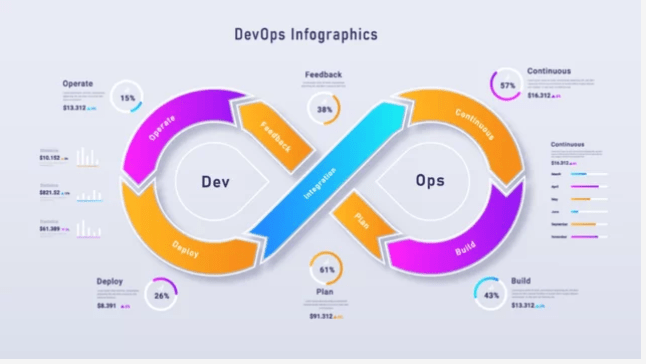Table of Contents
ToggleIntroduction.
In the modern era of software development, speed, scalability, and reliability define success. DevOps automation has emerged as a crucial practice that bridges the gap between development and operations, ensuring seamless collaboration, faster deployment, and continuous improvement. By integrating automation tools into every stage of the DevOps lifecycle, teams can eliminate repetitive manual tasks and deliver highquality software at unprecedented speed.
Automation in DevOps pipelines transforms the way organizations build, test, and deploy applications, reducing human error while increasing consistency. The combination of continuous integration (CI) and continuous delivery (CD) ensures that every code change is automatically built, tested, and deployed in a reliable manner. With DevOps CI/CD automation, businesses can release features to users faster, improving customer satisfaction and competitive advantage.
Infrastructure as Code (IaC) tools like Terraform, Ansible, and CloudFormation allow engineers to define cloud infrastructure through code, enabling reproducibility and version control. This approach not only accelerates cloud automation but also enhances scalability and disaster recovery capabilities. Automation in cloud computing empowers DevOps engineers to provision servers, configure environments, and deploy containers automatically. Modern platforms such as Kubernetes and Docker make container orchestration simpler, ensuring efficient resource utilization and rapid scaling. Jenkins, GitHub Actions, and GitLab CI/CD are widely used DevOps tools that automate code integration, testing, and deployment workflows.
These tools enable teams to maintain a robust DevOps pipeline, ensuring every software update moves seamlessly from development to production. Monitoring automation through tools like Prometheus, Grafana, and Datadog ensures proactive issue detection and faster incident response. Incorporating DevSecOps automation adds another layer of security by integrating automated vulnerability scanning and compliance checks into pipelines. Automation in DevOps fosters a culture of continuous feedback, where developers can quickly identify bugs, fix issues, and improve software quality. It eliminates bottlenecks caused by manual handoffs and ensures a smoother collaboration between development, testing, and operations teams.
DevOps automation best practices emphasize scalability, repeatability, and efficiency, helping organizations adapt to rapid technological changes.
Whether you’re deploying microservices, managing hybrid clouds, or building containerized applications, automation remains at the core of success. By leveraging cloud-native automation techniques, companies can optimize performance, reduce costs, and accelerate innovation. Automated testing ensures code quality through integration, unit, and regression tests without human intervention. This streamlines software delivery pipelines and guarantees that every release meets production-grade standards. With CI/CD automation, teams can deploy new versions multiple times a day instead of once a month.
This agility enables faster feedback loops, quicker feature rollouts, and improved user experiences.
In addition, DevOps workflow automation promotes collaboration through visibility and transparency across all project stages. As organizations move toward hybrid cloud and multi-cloud architectures, automation frameworks help manage complex deployments efficiently. Configuration management tools like Chef and Puppet automate environment setup, ensuring consistency across servers and clusters.
Orchestration tools streamline workflows by coordinating multiple automated processes across distributed systems. The adoption of AI-driven automation and AIOps takes DevOps to the next level, enabling predictive analytics and self-healing systems. Automation enhances not just technical operations but also business performance, helping companies deliver value faster. By integrating automation into DevOps practices, organizations achieve faster delivery, improved stability, and continuous optimization.
It empowers teams to focus on innovation rather than routine maintenance or troubleshooting.
DevOps automation solutions reduce downtime, improve system uptime, and maintain consistent user experiences across environments. In a world where digital transformation drives every industry, automating DevOps workflows has become a necessity, not an option. The synergy of CI/CD pipelines, cloud infrastructure, and automated deployment creates a streamlined, scalable, and intelligent ecosystem. As automation evolves, it becomes the foundation for continuous delivery, ensuring that software development keeps pace with modern business demands.
The true power of DevOps automation lies in its ability to unify tools, processes, and people under a common goal: rapid, reliable, and repeatable delivery. With every automation script, every pipeline, and every deployment, organizations move closer to achieving operational excellence. This transformation enables enterprises to innovate faster, respond to market changes quickly, and maintain high-quality standards. Automation frameworks not only simplify operations but also strengthen security, compliance, and governance.
From startups to global enterprises, every organization benefits from automating its DevOps lifecycle for smarter, faster delivery.
As technologies like Kubernetes, Docker, and Terraform continue to evolve, the potential for intelligent automation expands even further. Automation ensures that DevOps is not just a methodology but a sustainable, data-driven approach to continuous improvement. It paves the way for scalable DevOps pipelines, where each process from code commit to deployment is optimized for efficiency. The integration of monitoring, testing, and deployment automation minimizes downtime and maximizes productivity.
DevOps automation strategies enable faster innovation, continuous feedback, and measurable business outcomes. With the rise of cloud-native applications and microservices, automation ensures reliability in even the most complex environments. DevOps automation is the backbone of modern software engineering enabling smarter, faster, and more resilient software delivery. By embracing automation, organizations set the stage for continuous growth, agility, and success in the digital era.
What Is DevOps Automation?
DevOps automation is the process of using technology and tools to automate the repetitive, time-consuming, and error-prone tasks involved in software development and IT operations. It forms the foundation of modern DevOps practices, enabling teams to build, test, deploy, and monitor applications more efficiently. At its core, automation in DevOps unites development (Dev) and operations (Ops) teams to collaborate seamlessly and deliver value continuously. Instead of manually configuring servers or running deployment scripts, engineers rely on automated systems that perform these actions consistently.
This shift towards automation allows organizations to accelerate software delivery while maintaining stability and reliability. DevOps automation minimizes manual intervention and brings uniformity to complex workflows across diverse environments. It ensures that every change to the codebase passes through predefined stages like build, test, deploy, and monitor without human errors. By introducing automation, teams can focus more on innovation and problem-solving rather than routine maintenance. Automation in DevOps pipelines streamlines the entire software lifecycle, from code integration to production deployment.
One of the most important concepts in DevOps automation is Continuous Integration (CI), where code changes are automatically merged and tested. CI helps detect bugs early, preventing integration issues from slowing down development. The next step, Continuous Delivery (CD), ensures that tested code is automatically deployed to staging or production environments. Together, CI/CD automation allows developers to release software updates faster, safer, and more frequently. Infrastructure as Code (IaC) is another critical element of DevOps automation, using tools like Terraform, Ansible, and CloudFormation. IaC enables engineers to define and manage infrastructure using configuration files instead of manual setup. This approach ensures that environments are reproducible, version-controlled, and consistent across cloud providers.
In the world of cloud computing, automation helps teams dynamically scale resources and manage infrastructure efficiently. Cloud automation tools provision servers, configure environments, and deploy containers automatically, reducing operational overhead. Containerization technologies like Docker and Kubernetes have become central to DevOps automation strategies. They simplify application deployment by packaging software with all its dependencies, ensuring consistency across development and production. With Kubernetes automation, teams can orchestrate containers, balance workloads, and roll out updates with minimal downtime.
Jenkins, GitHub Actions, and GitLab CI/CD are among the most popular DevOps automation tools used to build powerful pipelines.
These tools integrate seamlessly with repositories, automating everything from testing to deployment.
Automated testing plays a major role in DevOps automation, verifying code quality through unit, integration, and performance tests. It ensures that new features do not break existing functionality and that every deployment meets quality standards. Beyond deployment, monitoring automation keeps systems healthy by collecting metrics, detecting anomalies, and triggering alerts.
Tools like Prometheus, Grafana, and Datadog provide real-time insights into performance and reliability.
Some advanced systems even trigger auto-remediation, where scripts automatically fix detected issues without human intervention. This concept of self-healing infrastructure represents the next evolution of DevOps automation. Automation in DevOps is not limited to tools it’s also a cultural shift toward continuous improvement and shared responsibility. By automating pipelines and feedback loops, teams can experiment quickly and recover rapidly from failures.
The combination of automation, collaboration, and monitoring transforms DevOps into a high-performance ecosystem. DevOps workflow automation improves efficiency by connecting multiple tools and processes into a unified pipeline. Each phase from code commit to deployment is defined, repeatable, and measurable.
This consistency reduces human dependency and ensures faster time-to-market for new products.
Security automation (DevSecOps) integrates vulnerability scanning and compliance checks directly into the pipeline.
It ensures that security is built into every stage of development rather than added at the end.
Automation also plays a role in configuration management, using tools like Chef or Puppet to maintain consistent server states. With the rise of AI and machine learning, automation in DevOps is becoming more intelligent and predictive. AIOps platforms can analyze data, predict system failures, and recommend optimizations automatically. This evolution marks a shift from simple scripting to intelligent automation capable of learning from past incidents. DevOps automation benefits include faster deployments, improved collaboration, higher quality, and reduced costs. It empowers teams to deliver continuous value while maintaining operational control and visibility.
Organizations embracing automation see measurable improvements in productivity and customer satisfaction.
From startups to enterprises, every business that adopts DevOps automation frameworks gains agility and resilience. Automation removes bottlenecks and ensures that software delivery aligns with business objectives.
It creates a repeatable, scalable process that supports rapid innovation and adaptation to market needs.
DevOps automation is not just about tools it’s about transforming how teams deliver software.
It replaces manual processes with intelligent, data-driven systems that enhance speed, accuracy, and collaboration. As technology continues to evolve, automation remains the driving force behind efficient, reliable, and smarter software delivery.
Why Automation Matters in DevOps.
Automation is the beating heart of the DevOps philosophy, enabling teams to deliver software faster, safer, and more efficiently. In traditional IT and software development, manual processes often caused delays, inconsistencies, and human errors. With DevOps automation, organizations replace repetitive manual work with intelligent, repeatable workflows. This shift reduces friction between development and operations teams, fostering smoother collaboration. The main goal of automation in DevOps is to eliminate bottlenecks and accelerate the software delivery pipeline. By automating build, test, deployment, and monitoring processes, teams achieve consistent results every time.
Automation tools like Jenkins, GitLab CI, and GitHub Actions help ensure that code is integrated and tested automatically. This reduces integration issues and allows developers to focus on writing quality code rather than managing environments. Continuous Integration (CI) ensures that every code commit is automatically built and validated against the main branch. Continuous Delivery (CD) extends this automation, deploying tested builds to staging or production environments seamlessly. Together, CI/CD pipelines enable organizations to release new features multiple times a day instead of once a month.
This rapid delivery capability enhances agility and improves response time to market changes.
Automation also increases software reliability, since every process follows a defined and tested pattern.
Unlike manual deployments, automated pipelines reduce the chance of human mistakes or skipped steps.
Infrastructure as Code (IaC) adds another layer of automation by managing servers and cloud infrastructure through code. Using tools like Terraform, Ansible, or CloudFormation, teams can deploy and scale environments in minutes. This ensures consistency across development, testing, and production systems no more “it works on my machine” problems. Automation is also critical for cloud-native DevOps workflows, where dynamic scaling and multi-cloud deployments are common.
Kubernetes and Docker provide containerization and orchestration that automate how applications are deployed and managed. These tools allow organizations to run workloads efficiently across clusters with minimal manual intervention. In DevOps monitoring, automation ensures real-time visibility into application health and performance. Tools like Prometheus, Grafana, and Datadog automatically collect and analyze system metrics.
This allows teams to detect anomalies quickly and take corrective actions before users are affected.
Some organizations even use auto-remediation scripts, where the system automatically fixes known issues.
Such self-healing infrastructure demonstrates how automation reduces downtime and improves reliability.
Another reason automation matters is speed businesses must deliver updates faster to stay competitive.
Manual testing, provisioning, and deployment simply can’t keep up with today’s agile development pace.
Automation provides the necessary speed while maintaining control, consistency, and quality.
Security automation, or DevSecOps, integrates vulnerability scanning and compliance checks into CI/CD pipelines. This ensures that every release meets security standards without slowing down delivery cycles.
By shifting security left, automation helps detect and fix vulnerabilities earlier in the development process.
Automation in DevOps also improves team collaboration by standardizing workflows across departments.
Everyone developers, testers, and operators works from the same automated pipeline, reducing miscommunication.
It enhances transparency because every build, test, and deployment step is logged and traceable.
Automation fosters a culture of continuous improvement, where teams can quickly experiment and learn from results. Since feedback loops are faster, organizations can adapt to user feedback and market trends more effectively. Automation not only accelerates software delivery but also improves resource utilization and cost efficiency. By reducing manual labor and repetitive tasks, teams save time and operational expenses.
AI-driven automation and AIOps take this further by using data to predict incidents and optimize performance.
This predictive capability helps prevent outages before they occur, making operations more resilient.
Automation in DevOps pipelines enhances scalability, ensuring systems can handle spikes in traffic effortlessly.
It enables continuous deployment across multiple environments, keeping software updates consistent worldwide.
Moreover, automation ensures compliance by enforcing governance policies automatically during each pipeline run.
For growing enterprises, automation supports expansion without requiring large increases in team size.
The consistency it provides allows teams to maintain quality even as the system grows in complexity.
Automation empowers developers to innovate confidently, knowing that testing and deployment are reliable.
It shortens feedback cycles, speeds up releases, and reduces the time between idea and customer value.
DevOps automation transforms how software is built and delivered turning manual, error-prone processes into smooth, predictable workflows.
It’s not just about technology; it’s about creating a culture of efficiency, reliability, and continuous delivery.
In the fast-paced digital landscape, automation isn’t optional it’s the foundation of every successful DevOps strategy.
Key Areas Where DevOps Uses Automation
Let’s break down where automation plays the biggest roles in a typical DevOps workflow:
1. Continuous Integration (CI).
Continuous Integration (CI) is one of the foundational pillars of DevOps automation, designed to streamline the process of integrating code changes from multiple developers into a shared repository.
In traditional workflows, merging code manually often caused integration conflicts and delayed releases.
With CI automation, every code commit triggers an automated build and test sequence that validates the new code instantly.
This ensures that bugs, syntax errors, or integration issues are detected early in the development cycle.
Tools like Jenkins, GitHub Actions, GitLab CI, and CircleCI make CI implementation simple and consistent across projects. They automatically compile the source code, execute unit and integration tests, and generate reports for developers. Automated testing within the CI pipeline maintains code quality and prevents broken builds from reaching production. By continuously merging and validating changes, teams maintain a stable main branch ready for deployment at any time.
CI encourages frequent commits, smaller code changes, and faster feedback loops all key elements of agile DevOps practices. It also reduces time spent on manual testing and debugging, accelerating software delivery cycles.
A well-designed CI pipeline integrates seamlessly with version control systems like Git, ensuring full traceability of every change. Incorporating static code analysis and security scanning within CI further enhances reliability and compliance. CI acts as the foundation for Continuous Delivery (CD), paving the way for automated deployments. When combined, CI/CD pipelines help organizations achieve true continuous delivery and deployment agility. Cloud-based CI tools make it easy to scale builds across distributed systems, improving efficiency and speed. Automation in CI ensures consistency across environments, minimizing the “it works on my machine” problem. By removing manual intervention, CI enables teams to focus on innovation instead of repetitive integration tasks. It creates a culture of accountability and transparency, where every code change is visible and validated automatically. Continuous Integration strengthens collaboration, reduces risk, and forms the backbone of an efficient DevOps automation pipeline.
2. Continuous Delivery (CD).
Continuous Delivery (CD) is the next crucial phase of the DevOps automation pipeline, extending the principles of Continuous Integration (CI) into deployment. While CI ensures that code is built and tested automatically, CD automation focuses on delivering that tested code to production-like environments reliably and repeatedly.
The goal of CD is to make software always ready for release at the click of a button or even fully automatically.
By automating deployment processes, CD eliminates the manual steps that often cause errors, downtime, or delays.
Tools like Jenkins, GitLab CI/CD, Spinnaker, and Argo CD enable smooth, automated deployments across environments. They integrate directly with version control systems, ensuring that every change can be tracked, verified, and rolled out safely. Continuous Delivery pipelines often include automated integration, testing, staging, and approval stages before final release. Through these automated stages, teams can detect issues earlier and reduce the risk of failed deployments. Containerization technologies such as Docker and Kubernetes enhance CD by allowing applications to be packaged and deployed consistently.With Kubernetes automation, rolling updates and blue-green deployments become easier to manage.
CD ensures that all infrastructure and configuration changes are version-controlled and reproducible.
This consistency helps maintain stable environments across development, testing, and production.
Infrastructure as Code (IaC) tools like Terraform or Ansible play a major role by automating environment provisioning. Together, IaC and CD create a seamless flow from code commit to cloud deployment.
Continuous Delivery automation also supports faster feedback loops, helping teams identify performance and security issues quickly. By reducing the manual workload, CD allows developers and operations teams to focus on innovation instead of maintenance. It ensures that software can be released at any time, increasing flexibility and business responsiveness.
Automated deployment pipelines minimize human error and enhance reliability, scalability, and speed.
Continuous Delivery is about making software deployment a safe, repeatable, and continuous process a core driver of success in DevOps automation.
3. Infrastructure as Code (IaC).
Infrastructure as Code (IaC) is a fundamental pillar of DevOps automation, enabling teams to define, manage, and provision infrastructure using code instead of manual configuration.
It transforms infrastructure setup into a programmable, repeatable process that can be automated and version-controlled. With IaC, engineers describe cloud resources servers, databases, networks, and storage in configuration files or scripts.
This ensures that environments can be created, destroyed, and replicated consistently across multiple stages.
Tools like Terraform, Ansible, Puppet, and AWS CloudFormation are widely used to implement IaC practices.
They allow teams to treat infrastructure the same way they treat application code, stored in repositories and managed through pull requests. This brings visibility, collaboration, and traceability to infrastructure changes, reducing the risk of configuration drift.
Infrastructure automation through IaC eliminates the need for manual provisioning, saving time and minimizing human errors. In a cloud computing environment, IaC helps automate scaling, resource allocation, and deployment across providers like AWS, Azure, and GCP. It ensures that all environments from development to production remain identical and predictable. By integrating IaC into CI/CD pipelines, teams can automatically spin up test environments for each deployment cycle.
This improves testing accuracy and shortens feedback loops between development and operations.
IaC also enhances disaster recovery by enabling quick environment restoration from configuration files.
When combined with configuration management tools, IaC ensures systems remain compliant and up to date.
The declarative nature of IaC allows engineers to describe the desired state rather than executing step-by-step commands.
Automation platforms can then reconcile differences automatically to achieve that state. This level of consistency improves security, governance, and operational efficiency across large-scale systems. Infrastructure as Code automation promotes agility by allowing teams to deploy infrastructure changes alongside application updates.
It lays the groundwork for cloud-native DevOps practices, supporting microservices, containers, and hybrid environments. IaC transforms infrastructure management into a scalable, reliable, and automated process the backbone of modern DevOps automation.
4. Monitoring and Alerts.
Monitoring and Alerts are vital components of DevOps automation, ensuring continuous visibility into system performance and reliability.
Automated monitoring tools like Prometheus, Grafana, and Datadog collect metrics, logs, and traces in real time.
These insights help teams track application health, resource usage, and response times across environments.
Automation enables instant alerts when performance thresholds are breached or failures occur.
Such proactive notifications allow DevOps teams to respond to incidents before they impact users.
Integrating monitoring into CI/CD pipelines ensures early detection of bugs or deployment issues.
Some advanced systems use auto-remediation scripts to fix recurring problems automatically.
This creates a self-healing infrastructure capable of maintaining uptime with minimal human intervention.
Effective monitoring and alert automation improve reliability, security, and customer satisfaction.
Ultimately, they close the feedback loop in DevOps workflows, driving continuous improvement and operational excellence.
Common DevOps Automation Tools
| Category | Tools |
|---|---|
| CI/CD | Jenkins, GitHub Actions, GitLab, CircleCI |
| IaC | Terraform, Ansible, Chef, Puppet |
| Containerization | Docker, Kubernetes |
| Monitoring | Prometheus, Grafana, ELK Stack |
| Security | Snyk, Trivy, SonarQube |
Each tool plays a different role and together, they build a powerful automated pipeline from code commit to production release.
Real-World Example: Automating a Simple Deployment
Imagine you push new code to GitHub.
Here’s what automation can do:
- GitHub Action triggers when code is pushed.
- The pipeline builds your app and runs tests automatically.
- If tests pass, it packages the app in a Docker container.
- The pipeline then deploys the container to a Kubernetes cluster.
- Monitoring tools track performance and send alerts if something goes wrong.
All of this happens automatically often within minutes.
Getting Started with DevOps Automation
If you’re new to automation, start small:
- Automate your build and test process with GitHub Actions or Jenkins.
- Use Terraform or Ansible to automate environment setup.
- Introduce automated monitoring and alerts to catch issues early.
The key is incremental automation start with the most repetitive or error-prone tasks, then expand as you grow.
The Future of DevOps Automation
As AI and machine learning enter the DevOps space, automation is evolving into AIOps intelligent automation that predicts failures, optimizes resources, and self-heals systems.
The end goal? Fully autonomous pipelines that deliver software faster, safer, and smarter.
Final Thoughts
DevOps automation isn’t about replacing humans it’s about empowering teams to focus on innovation rather than repetitive tasks.
By automating your builds, deployments, infrastructure, and monitoring, you create a development environment where speed meets stability.
If your team is still doing everything manually, now’s the time to start your automation journey one script, one pipeline, and one improvement at a time.





